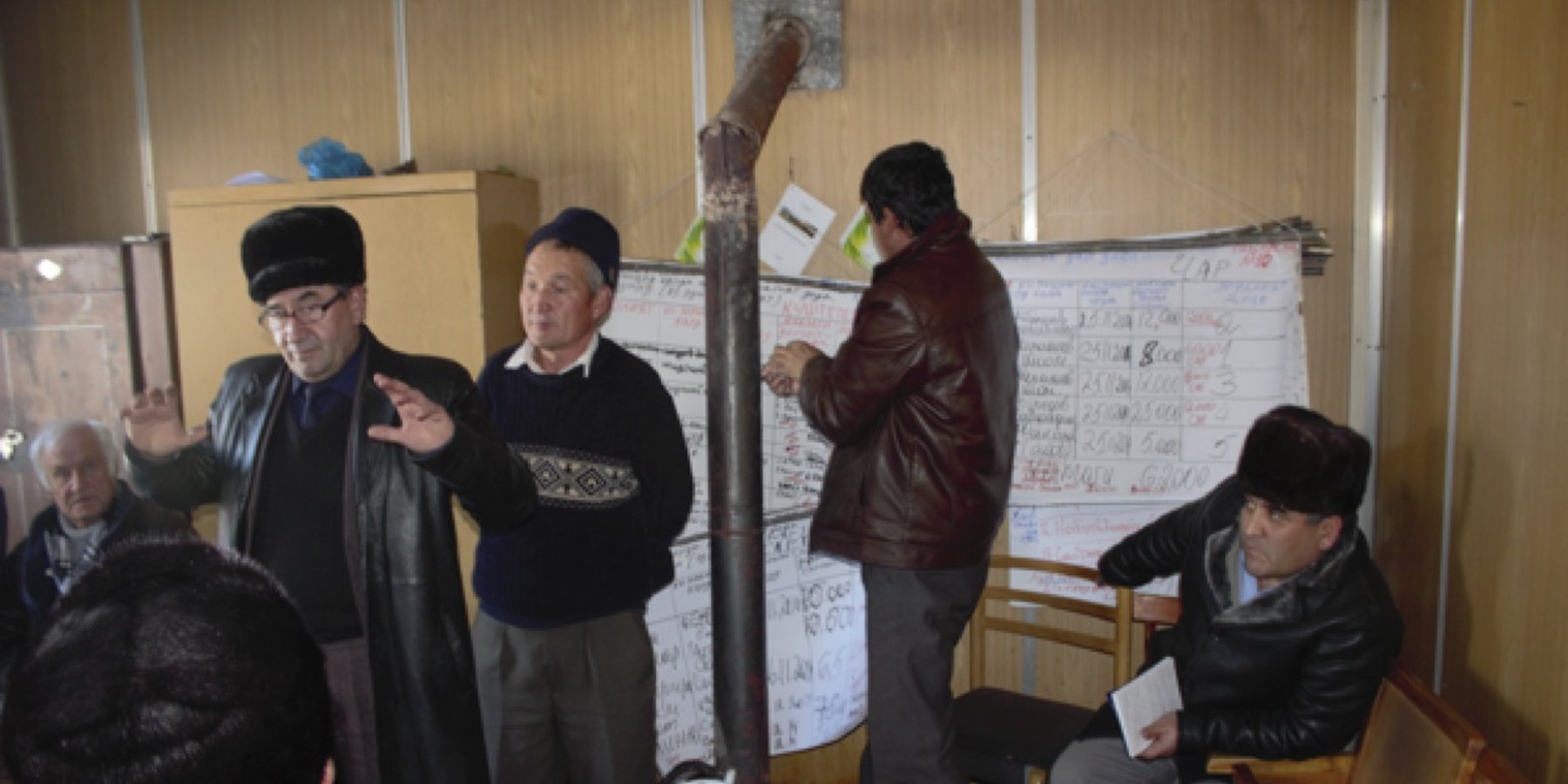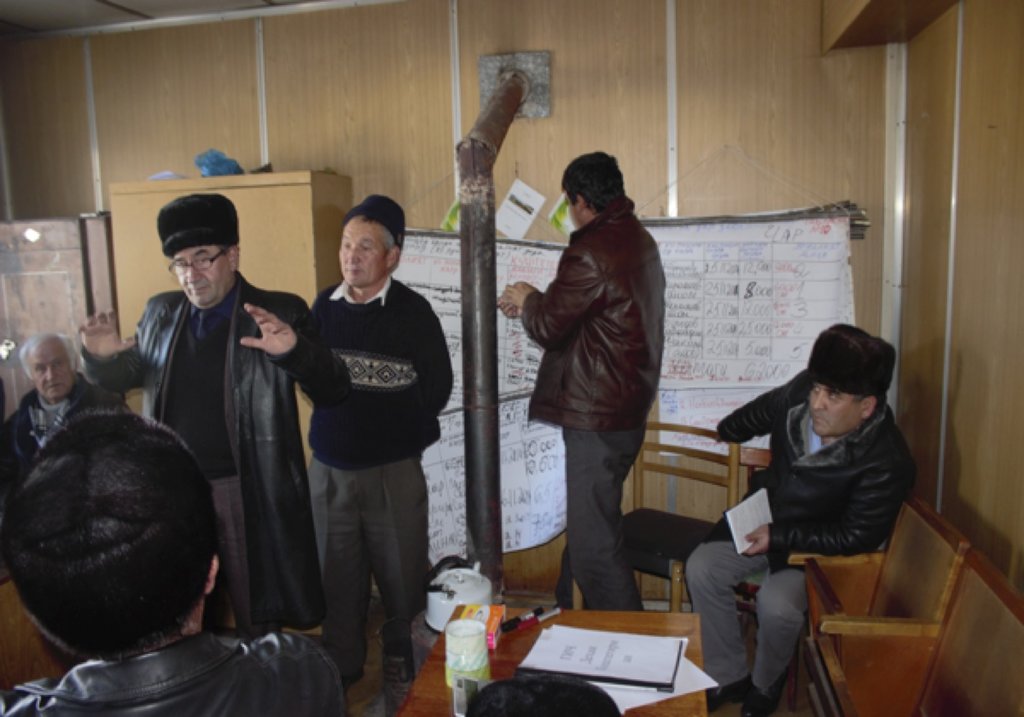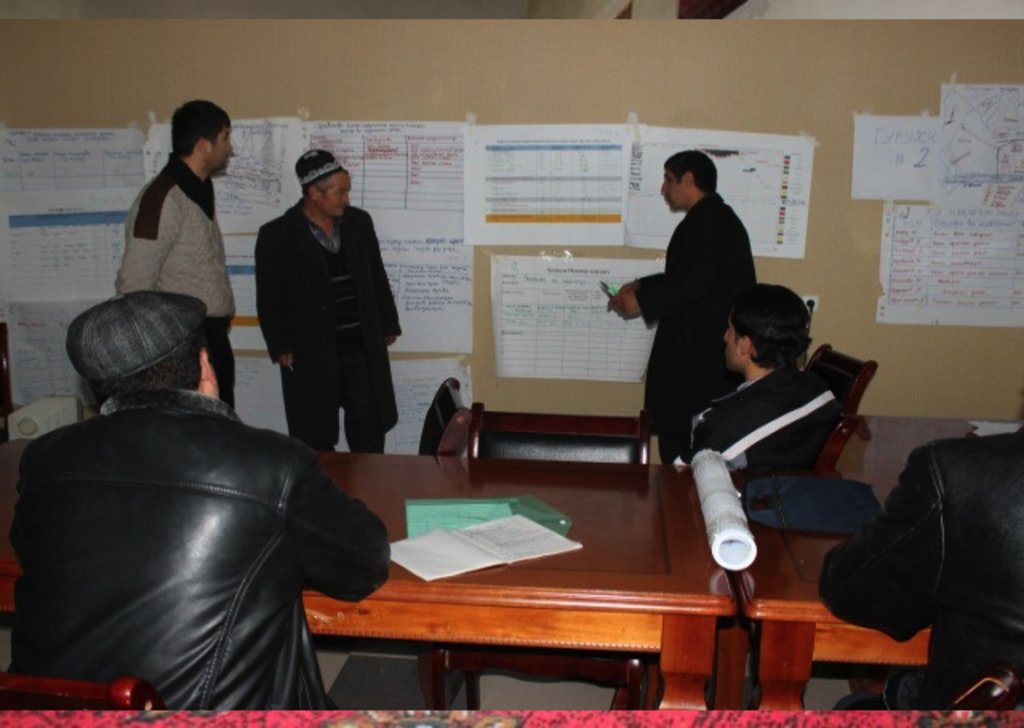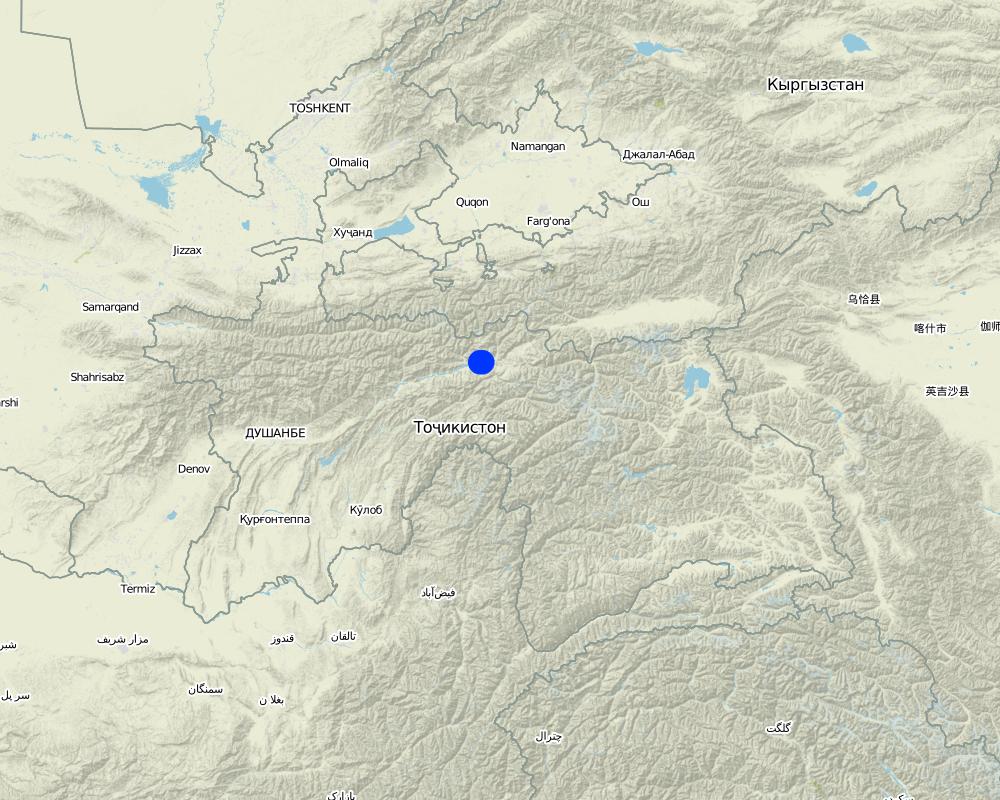Pasture and Livestock Management Plan [ប្រទេសតាហ្ស៊ីគីស្ថាន]
- ការបង្កើត៖
- បច្ចុប្បន្នភាព
- អ្នកចងក្រង៖ Askarsho Zevarshoev
- អ្នកកែសម្រួល៖ –
- អ្នកត្រួតពិនិត្យច្រើនទៀត៖ Yacime Khadraoui, Maximilian Knoll
Накшаи Идоракунии Чорво ва Чарогох
approaches_3459 - ប្រទេសតាហ្ស៊ីគីស្ថាន
ពិនិត្យមើលគ្រប់ផ្នែក
ពង្រីកមើលទាំងអស់ បង្រួមទាំងអស់1. ព័ត៌មានទូទៅ
1.2 ព័ត៌មានលម្អិតពីបុគ្គលសំខាន់ៗ និងស្ថាប័នដែលចូលរួមក្នុងការវាយតម្លៃ និងចងក្រងឯកសារនៃវិធីសាស្ត្រផ្សព្វផ្សាយ
ឈ្មោះគម្រោងដែលបានចងក្រងឯកសារ/ វាយតម្លៃលើវិធីសាស្ត្រផ្សព្វផ្សាយ (បើទាក់ទង)
Environmental Land Management and Rural Livelihoods (ELMAR)ឈ្មោះអង្គភាពមួយ (ច្រើន) ដែលបានចងក្រងឯកសារ/ វាយតម្លៃលើវិធីសាស្ត្រផ្សព្វផ្សាយ (បើទាក់ទង)
Aga Khan Foundation (Aga Khan Foundation) - ប្រទេសស្វ៊ីស1.3 លក្ខខណ្ឌទាក់ទងទៅនឹងការប្រើប្រាស់ទិន្នន័យដែលបានចងក្រងតាមរយៈវ៉ូខេត
តើពេលណាដែលទិន្នន័យបានចងក្រង (នៅទីវាល)?
15/07/2014
អ្នកចងក្រង និង(បុគ្គលសំខាន់ៗ)យល់ព្រមទទួលយកនូវលក្ខខណ្ឌនានាទាក់ទងទៅនឹងការប្រើប្រាស់ទិន្នន័យដែលបានចងក្រងតាមរយៈ វ៉ូខេត:
បាទ/ចា៎
1.4 ការយោងមួយ (ច្រើន) ទៅលើ (កម្រង) បញ្ជីសំណួរនៃបច្ចេកទេស SLM
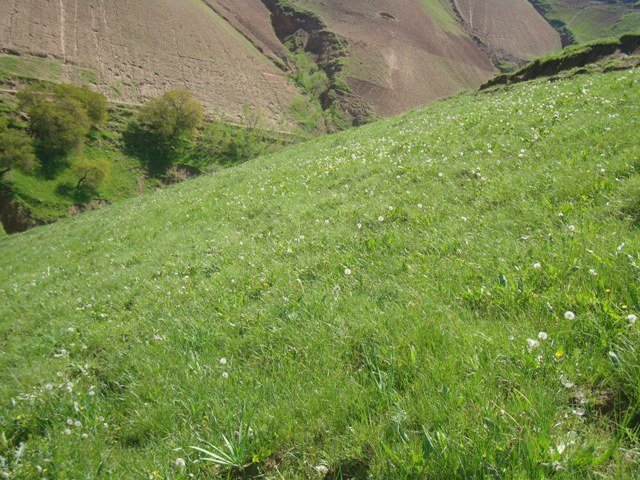
Rehabilitation of degraded pastures with alfalfa [ប្រទេសអាហ្វហ្គានិស្ថាន]
Degraded pastures are restored with alfalfa through broad seeding method. The area is put under quarantine for three years to allow for the pasture to restore sufficiently.
- អ្នកចងក្រង៖ Bettina Wolfgramm
2. ការពណ៌នាអំពីវិធីសាស្ត្រផ្សព្វផ្សាយ SLM
2.1 ពណ៌នាសង្ខេបខ្លីពីវិធីសាស្ត្រផ្សព្វផ្សាយ
"Pasture and Livestock Management Plan" is a participatory approach which is guiding pasture users, members of Pasture User Unions and Pasture User Groups to develop their action plan on pasture and livestock management. The approach brings together stakeholders, who are involved at any stage in pasture management or can contribute to or impede the implementation of the pasture livestock management plan.
2.2 ពណ៌នាលម្អិតពិវិធីសាស្ត្រផ្សព្វផ្សាយ
ពណ៌នាលម្អិតពិវិធីសាស្ត្រផ្សព្វផ្សាយ:
Pasture and Livestock Management Plan (PLMP) Approach is a participatory approach towards the development of a pasture plan with communities to ensure a sustainable use of pasture resources. It was especially designed for the needs of the Pasture User Union, a new structure allowed to establish at community level to implement better management of their pasture resources. Though a step-by-step analysis of the current situation a community will come up with detailed action plan for the following three years. The PLMP involves, but is not limited to, the establishment of a committee involved in preparation of the PLMP, as well as a stakeholder analysis and the determination of the carrying capacity of pasture resources by comparing the existing fodder resources and requirements for the fodder. Based on that analysis, an action plan will be developed with involvement of all stakeholders to reach an agreement on approaches and technologies to implement the interventions. The PLMP will lead to the development of the Action Plan based on the discussion between different stakeholders. In the process of the plan development with consideration of an expert a clear roles and responsibilities of all involved actors/stakeholder in a defined timeframe will be identified.
The main objectives is to support land users with development of actions, which contribute to the sustainable development of pasture resource and livestock development. The central focus is given to balance the need of the livestock owners to improve livestock productivity with compromising the environmental conditions for the next generations and ecosystem services. The planning process should contribute to better management of pasture lands, rehabilitation of degraded pastures, resolving any existing conflict over pasture use, awareness raising on the role of pasture land for ecosystem services and overall trends in development with regards to use and management of pasture resources.
The process is based on participatory methods with involvement of different stakeholders capturing main principles for land use planning. The process includes pasture users/livestock owners who are involved in day to day management of pasture lands, local government with related department to pasture use, land owners, different departments of local government such as forestry, land use committee, environmental protection etc.
The approach is conducted in three main stages: In the firs stage consultation with pasture users will be held to identify the need for development of a pasture plan. Then an inventory of all land resources, including pasture land and livestock numbers will be conducted. In the third stage a workshop will be conducted with involvement of all stakeholders, where the pasture plan will be developed. In the final stage of the pasture plan development an action plan with defined clear activities in a given frame and assigned responsible persons will be developed.
Land users, who also own livestock appreciate their involvement in the pasture development planning. They also like when their voice is taken into consideration in making any decision with regards to the pasture use.
2.3 រូបភាពនៃវិធីសាស្ត្រផ្សព្វផ្សាយ
កំណត់សំគាល់ទូទៅរបស់រូបថត:
Participants reflecting on the overall process of the PLMP approach with all steps involved starting with setting up objectives and principles, analysis of stakeholders up to development of action plan.
2.5 ប្រទេស/តំបន់/ទីតាំងកន្លែង ដែលវិធីសាស្ត្រផ្សព្វផ្សាយត្រូវបានអនុវត្តន៍
ប្រទេស:
ប្រទេសតាហ្ស៊ីគីស្ថាន
តំបន់/រដ្ឋ/ខេត្ត:
Rasht Valley/Lakhsh District
បញ្ជាក់បន្ថែមពីលក្ខណៈនៃទីតាំង:
PUUs established in Rasht Valley under ELMARLP
Map
×2.6 កាលបរិច្ឆេទនៃការចាប់ផ្តើម និងបញ្ចប់នៃវិធីសាស្រ្តផ្សព្វផ្សាយនេះ
ប្រសិនអត់ចាំឆ្នាំ សូមចង្អុលបង្ហាញកាលបរិច្ឆេទប្រហែលៗពេលដែលវិធីសាស្ត្រផ្សព្វផ្សាយត្រូវបានចាប់ផ្តើមប្រើ:
តិចជាង 10ឆ្នាំមុន (ថ្មី)
2.7 ប្រភេទនៃវិធីសាស្ត្រផ្សព្វផ្សាយ
- ផ្អែកលើគម្រោង/កម្មវិធី
2.8 គោលបំណង/ទិសដៅសំខាន់នៃវិធីសាស្ត្រផ្សព្វផ្សាយ
The main objective is to support land users with the development of actions, that contribute to the sustainable development of pasture resource and livestock development. The central focus is to balance the need of the livestock owners to improve livestock productivity without compromising the environmental conditions for next generations and ecosystem services. The planning process should contribute to better management of pasture lands, rehabilitation of degraded pastures, resolving any existing conflicts over pasture use, raise awareness on the role of pasture land for ecosystem services and overall trends in development with regards to use and management of pasture resources.
2.9 លក្ខខណ្ឌអនុញ្ញាត ឬរារាំងការអនុវត្តន៍បច្ចេកទេសដែលស្ថិតនៅក្រោមវិធីសាស្រ្តផ្សព្វផ្សាយ
សង្គម/វប្បធម៌/ និងតម្លៃនៃសាសនា
- រារាំង
Communities are used to an ad hoc use of natural resources and therefore sometime not willing to structured planning processes in terms of use of pasture resources.
ភាពអាចរកបាននៃធនធានហិរញ្ញវត្ថុ និងសេវាកម្ម
- រារាំង
In the case that funding is not available from project side, it may hinder further implementation of the actions planned under the PLMP approach.
បរិបទនៃស្ថាប័ន
- អំណោយផល
The PLMP approach is specifically designed for the PUU, which are legally registered institutes under the governmental law. This enables the process to run continously.
ការសហការ/ការសម្របសម្រួលតួអង្គពាក់ព័ន្ធ
- អំណោយផល
Depending on the leadership of the institutional structure, if well managed, it can enable collaboration among different stakeholders
- រារាំង
The newly established PUUs do not have enough power to influence the institutes in which stakeholders who are not interested in the sustainable use of pasture resources work hinder the planning process.
ក្របខណ្ឌច្បាប់ (សិទ្ធិកាន់កាប់ដីធ្លី កម្មសិទ្ធីប្រើប្រាស់ដីនិងទឹក)
- អំណោយផល
mainly used by the PUUs, which are are functioning in the framework of state law
គោលនយោបាយ
- អំណោយផល
The plan is developed for the Pasture User Unions, which are legal structure responsible for pasture management at community level.
អភិបាលកិច្ចដី (ការសម្រេចចិត្ត ការអនុវត្ត និងការរឹតបន្តឹង)
- អំណោយផល
The approach will enable community members (PUUs) to become legal owners of the pasture resources according to the Pasture Law of the Republic of Tajikistan.
ចំណេះដឹងស្តីពី SLM និងការទទួលបានការគាំទ្រផ្នែកបច្ចេកទេស
- អំណោយផល
Experts in the field are supported technically by project consultants, several trainings on the process and approach are conducted for them.
3. ការចូលរួម និងតួនាទីរបស់ភាគីពាក់ព័ន្ធ
3.1 អ្នកពាក់ព័ន្ធដែលបានចូលរួមក្នុងវិធីសាស្ត្រផ្សព្វផ្សាយ និងតួនាទីរបស់ពួកគេ
- អ្នកប្រើប្រាស់ដីក្នុងតំបន់/សហគមន៍
livestock owners and PUU members
involved in direct process development and implementation of the approach
- អង្គការសហគមន៍មូលដ្ឋាន
village organizations, pasture user unions
also registered in the framework of the state law and are represented in the PUU. mainly involved in mobilization of the community to participate in the development and implementation of the plan
- អ្នកឯកទេសគ្រប់គ្រងដីប្រកបដោយចីរភាព/ទីប្រឹក្សាបច្ចេកទេសកសិកម្ម
project consultants and technical staff
facilitate the process of developing the PLMP approach, capacity building on the approach for the members of PUU
- អង្គការក្រៅរដ្ឋាភិបាល
locally registered public organizations which are directly involved in the natural resource and environmental management
provide technical support to the community and land users; can also support with fundraising
- វិស័យឯកជន
entrepreneurs at local level
co-funding of the implementation of some of the practices from the PLMP
- រដ្ឋាភិបាលថ្នាក់មូលដ្ឋាន
local level government (sub-district authority), land use committee, committee of environmental protection, agriculture department etc.,
as one of the main stakeholders responsible for management of natural resource; can also provide overall supervision of the approach development; PUUs for which the PLMP is developed: legal structure under the Pasture Law of the Republic of Tajikistan.
ប្រសិនមានភាគីពាក់ព័ន្ធច្រើនចូលរួមសូមចង្អុលបង្ហាញភ្នាក់ងារដែលនាំមុខគេ:
Land Commttee
3.2 ការចូលរួមរបស់អ្នកប្រើប្រាស់ដីក្នុងតំបន់/ សហគមន៍ក្នុងតំបន់ក្នុងដំណាក់កាលផ្សេងគ្នានៃវិធីសាស្រ្តផ្សព្វផ្សាយ
| ការចូលរួមរបស់អ្នកប្រើប្រាស់ដីក្នុងតំបន់/សហគមន៍ក្នុងតំបន់ | សូមបញ្ជាក់នរណាត្រូវបានចូលរួម ព្រមទាំងពណ៌នាសកម្មភាពទាំងនោះ | |
|---|---|---|
| ការចាប់ផ្តើម/ការលើកទឹកចិត្ត | ការគាំទ្រពីខាងក្រៅ | livestock owners, PUU members; consultation with livestock owners, facilitation the process of establishment of PUUs |
| ការរៀបចំផែនការ | អន្តរកម្ម | land users, PUU members, pasture experts |
| ការអនុវត្តន៍ | អន្តរកម្ម | PUU members and expert from project; consultation with stakeholders, conduct workshop and development of the plan |
| ការត្រួតពិនិត្យ និងវាយតម្លៃ | ការគាំទ្រពីខាងក្រៅ | from project team and management of PUU |
3.4 ការសម្រេចចិត្តលើការជ្រើសរើសបច្ចេកទេស SLM
សូមបញ្ជាក់តើអ្នកណាជាអ្នកបានសម្រេចចិត្តក្នុងការជ្រើសរើសបច្ចេកទេសដើម្បីយកមកអនុវត្តន៍:
- អ្នកជំនាញឯកទេស SLM បន្ទាប់ពីបានប្រឹក្សាយោបល់ជាមួយអ្នកប្រើប្រាស់ដី
ចូរពន្យល់:
Mainly as a new approach, best practices from the WOCAT database were used by the SLM specialists to introduce to land users and traditional practices were also applied based on the knowledge of land users.
សូមបញ្ជាក់ តើការសម្រេចធ្វើឡើងដោយផ្អែកលើអ្វីជាមូលដ្ឋាន:
- វាយតម្លៃទៅលើចំណេះដឹងស្តីអំពី SLM ដែលបានចងក្រងជាឯកសារបានត្រឹមត្រូវ (ផ្អែកលើភស្តុតាងជាមូលដ្ឋានដើម្បីសម្រេចចិត្ត)
- បទពិសោធន៍ និងគំនិតផ្ទាល់ខ្លួន(ពុំមានចងក្រងជាឯកសារ)
4. ជំនួយបច្ចេកទេស ការកសាងសមត្ថភាព និងការគ្រប់គ្រងចំណេះដឹង
4.1 ការកសាងសមត្ថភាព/ បណ្តុះបណ្តាល
តើវគ្គបណ្តុះបណ្តាលបានផ្តល់ឱ្យអ្នកប្រើប្រាស់ដី/អ្នកពាក់ព័ន្ធផ្សេងៗទៀតដែរឬទេ?
បាទ/ចា៎
សូមបញ្ជាក់តើអ្នកណាត្រូវបានបណ្តុះបណ្តាល:
- អ្នកប្រើប្រាស់ដី
- បុគ្គលិកចុះទីវាល/អ្នកផ្តល់ប្រឹក្សាយោបល់
ទម្រង់នៃការបណ្តុះបណ្តាល:
- អនុវត្តន៍ជាមួយការងារ
- ការប្រជុំជាសាធារណៈ
ប្រធានបទបណ្តុះបណ្តាល:
"Pasture and Livestock Management Plan" methodology, proposal development for fund raising, Environmental Land Management
4.2 សេវាផ្តល់ប្រឹក្សាយោបល់
តើអ្នកប្រើប្រាស់ដីបានទទួលនូវសេវាផ្តល់ប្រឹក្សាដែរ ឬទេ?
បាទ/ចា៎
សូមបញ្ជាក់ប្រសិនបើសេវាកម្មប្រឹក្សាយោបល់ត្រូវបានផ្តល់ឱ្យ:
- នៅលើដីរបស់អ្នកប្រើប្រាស់ដី
ពណ៌នា/ពន្យល់:
During the project period continuos visits were organized to the project site to review the progress and provide advisory service. The project implmentation team consisting of different experts, including pasture, environmental specialists and monitoring and evaluation experts.
4.3 ការពង្រឹងសមត្ថភាពស្ថាប័ន (ការអភិរឌ្ឍន៍អង្គភាព)
តើស្ថាប័នទាំងអស់ត្រូវបានបង្កើតឡើង ឬពង្រឹងសមត្ថភាពតាមរយៈវិធីសាស្ត្រផ្សព្វផ្សាយដែរ ឬទេ?
- បាទ/ច៎ា បានខ្លាំង
សូមបញ្ជាក់ថាតើស្ថាប័នត្រូវបានពង្រឹង ឬបង្កើតឡើងនៅត្រឹមកម្រិតណា(ច្រើន)?
- ថ្នាក់មូលដ្ឋាន
ចូពណ៌នាពីស្ថាប័ន តួនាទី និងទំនួលខុសត្រូវ សមាជិក ។ល។:
Pasture User Union was established at sub-district level.
សូមបញ្ជាក់ប្រភេទនៃការគាំទ្រ:
- ហិរញ្ញវត្ថុ
- ការកសាងសមត្ថភាព/ បណ្តុះបណ្តាល
សូមផ្តល់ព័ត៌មានបន្ថែមទៀតឱ្យបានលម្អិត:
Different technical and administrative trainings were provided and the PUU was funded with certain amount for implementation of the PLMP approach.
4.4 ការត្រួតពិនិត្យ និងវាយតម្លៃ
តើការត្រួតពិនិត្យ និងវាយតម្លៃគឺជាផ្នែកមួយនៃវិធីសាស្ត្រដែរឬទេ?
បាទ/ចា៎
មតិយោបល់:
The final section of the PLMP is monitoring and evaluation. At each stage a responsible person among the stakeholders is assigned to conduct the plan implementation. In addition, the project team also conducts monitoring of the approach.
ប្រសិន បាទ/ច៎ា តើឯកសារនេះបានបង្កើតឡើងក្នុងគោលបំណងប្រើប្រាស់សម្រាប់ការត្រួតពិនិត្យ និងវាយតម្លៃដែរឬទេ?
បាទ/ចា៎
មតិយោបល់:
The implementing agency has a monitoring methodology, which will be used by the project team to conduct monitoring.
4.5 ការស្រាវជ្រាវ
តើការស្រាវជ្រាវ គឺជាផ្នែកមួយនៃវិធីសាស្រ្តដែរឬទេ?
ទេ
5. ថវិកា និងសម្ភារៈឧបត្ថម្ភពីខាងក្រៅ
5.1 ថវិកាប្រចាំឆ្នាំសម្រាប់ផ្សព្វផ្សាយ SLM
ប្រសិនបើចំនួនពិតប្រាកដនៃថវិកាប្រចាំឆ្នាំមិនត្រូវបានដឹងច្បាស់ សូមប្រាប់ពីចន្លោះនៃថវិកានោះ:
- 2,000-10,000
មតិយោបល់ (ឧ. ប្រភពសំខាន់នៃមូលនិធិ/ម្ចាស់ជំនួយចំបង):
World Bank in the framework of ELMARL - Environmental Land Management and Rural Livelihood project
5.2 ការគាំទ្រផ្នែកហិរញ្ញវត្ថុ / សម្ភារៈដែលបានផ្តល់ទៅឱ្យអ្នកប្រើប្រាស់ដី
តើអ្នកប្រើប្រាស់ដីបានទទួលការគាំទ្រផ្នែកហិរញ្ញវត្ថ/សម្ភារៈសម្រាប់ការអនុវត្តន៍បច្ចេកទេសដែរឬទេ:
ទេ
5.3 សូមបញ្ជាក់ពីធាតុចូលត្រូវបានផ្តល់បដិភាគ (រួមទាំងកម្លាំងពលកម្ម)
- គ្មាន
ប្រសិនបើកម្លាំងពលកម្មធ្វើដោយអ្នកប្រើប្រាស់ដី តើវាជាធាតុចូលដ៏សំខាន់មួយដែរ ឬទេ:
- ដោយស្ម័គ្រចិត្ត
មតិយោបល់:
This is traditional now and any project fund should be accompanied by contributions from communities, which is mainly labour on a voluntary basis
5.4 ឥណទាន
តើឥណទានដែលបានផ្តល់នៅក្រោមវិធីសាស្ត្រផ្សព្វផ្សាយសម្រាប់សកម្មភាព SLM នេះយ៉ាងដូចម្តេច?
ទេ
5.5 ការលើកទឹកចិត្ត ឬវិធីសាស្ត្រដ៏ទៃទៀត
តើមានការលើកទឹកចិត្តផ្សេងទៀត ឬឧបករណ៍ប្រើប្រាស់ដើម្បីលើកកម្ពស់ការអនុវត្តន៍បច្ចេកទេស SLM?
ទេ
6. ការវិភាគរកផលប៉ះពាល់ និងសេចក្តីសន្និដ្ឋាន
6.1 ផលប៉ះពាល់នៃវិធីសាស្ត្រផ្សព្វផ្សាយ
តើវិធីសាស្ត្រផ្សព្វផ្សាយបានផ្តល់សិទ្ធិអំណាចដល់អ្នកប្រើប្រាស់ដី ធ្វើឱ្យប្រសើរឡើងនូវការចួលរួមអ្នកពាក់ព័ន្ធ?
- ទេ
- បាទ/ច៎ា បន្តិចបន្តួច
- បាទ/ច៎ា ជាមធ្យម
- បាទ/ច៎ា បានខ្លាំង
It directly helped them to identify their status and understand their right to land use.
តើវិធីសាស្ត្រផ្សព្វផ្សាយជួយអ្នកប្រើប្រាស់ដីដើម្បីអនុវត្តន៍ និងថែទាំបច្ចេកទេស SLM?
- ទេ
- បាទ/ច៎ា បន្តិចបន្តួច
- បាទ/ច៎ា ជាមធ្យម
- បាទ/ច៎ា បានខ្លាំង
All technologies planned under the approach as part of their action plan were later financed by projects to implement.
after development of the pasture and livestock management plan the PUUs were supported financial from the ELMARL project to implement the plan
the plan is developed through conducted workshop with participation of all stakeholders, including land users, where they get opportunity to learn experiences of other stakeholders.
All stakeholders involved in the process including women and youth had an opportunity to make decisions in line with other stakeholders.
តើវីធីសាស្ត្រផ្សព្វផ្សាយនេះបានកាត់បន្ថយជំលោះឬទេ?
- ទេ
- បាទ/ច៎ា បន្តិចបន្តួច
- បាទ/ច៎ា ជាមធ្យម
- បាទ/ច៎ា បានខ្លាំង
Roles and responsibilities identified all stakeholder and one of the objective to mitigate conflict brought under discussion conflict over pasture use and tried to solve it to some extent.
តើវិធីសាស្ត្រផ្សព្វផ្សាយនេះផ្តល់សិទ្ធិអំណាចដល់សង្គមនិងសេដ្ឋកិច្ចដែលក្រុមមិនទទួលបានផលប្រយោជន៍?
- ទេ
- បាទ/ច៎ា បន្តិចបន្តួច
- បាទ/ច៎ា ជាមធ្យម
- បាទ/ច៎ា បានខ្លាំង
Women's role in livestock management was identified and empowered.
All stakeholders involved in the process including women and youth had an opportunity to make decisions in line with other stakeholders.
the approach give the land users/PUU members rights to become owner of the pasture under the Pasture Law of the Republic of Tajikistan
6.2 ការលើកទឹកចិត្តចម្បងៗរបស់អ្នកប្រើប្រាស់ដីសម្រាប់ការអនុវត្តបច្ចេកទេស SLM
- បង្កើនផលិតកម្ម
- ការកាត់បន្ថយការធ្លាក់ចុះគុណភាពដី
The rotation plan for rehabilitation of degraded pasture is applied.
- កាត់បន្ថយហានិភ័យនៃគ្រោះមហន្តរាយ
Watershed approach was applied to ban grazing in some areas to prevent land slide and mudflow as a result of degradation.
- ច្បាប់ និងបទបញ្ជា (ផាកពិន័យ)/ការប្រតិបត្តិ
The plan does not set certain rules at this stage to enforce the regulation, but the community is planning to negotiate and set certain rules in case of not following the regulations to implement the plan.
6.3 សកម្មភាពផ្សព្វផ្សាយដែលប្រកបដោយចីរភាព
តើអ្នកប្រើប្រាស់ដីអាចធ្វើឱ្យមានចីរភាពនូវអ្វីដែលត្រូវបានអនុវត្តន៍តាមរយៈវិធីសាស្ត្រផ្សព្វផ្សាយដែរឬទេ(ដោយពុំមានការគាំទ្រពីអ្នកខាងក្រៅ)?
- មិនប្រាកដ
ប្រសិន ទេ ឬមិនប្រាកដសូមបញ្ជាក់ និងពន្យល់:
depends on the availability of funding, leadership and support from other stakeholders, especially local government
6.4 ភាពខ្លាំង/ គុណសម្បត្តិនៃវិធីសាស្ត្រផ្សព្វផ្សាយ
| ភាពខ្លាំង/ គុណសម្បត្តិ/ ឱកាស ទស្សនៈរបស់អ្នកប្រើប្រាស់ដី |
|---|
| active participation in the development of the plan |
| better understanding of the current situation with regards to pasture use and importance of pasture plan development |
| ភាពខ្លាំង/ គុណសម្បត្តិ/ ឱកាស ទស្សនៈរបស់បុគ្គលសំខាន់ៗ |
|---|
| involvement of all stakeholders, especially land users and taking their knowledge and voice into consideration in decision making |
| building of the knowledge and opening a platform for collaboration between different stakeholders interested in sustainable management of pasture resources |
6.5 ភាពខ្សោយ/ គុណវិបត្តិនៃវិធីសាស្ត្រ និងរកដំណោះស្រាយ
| ភាពខ្សោយ/ គុណវិបត្តិ/ ហានិភ័យ ទស្សនៈរបស់អ្នកប្រើប្រាស់ដី | តើបច្ចេកទេសទាំងនោះបានដោះស្រាយបញ្ហាដូចម្តេច? |
|---|---|
| time consuming, requires resource in the short term | should be understand as a means of livelihoods and spend more time, improve understanding of better gain in a long term |
| ភាពខ្សោយ/ គុណវិបត្តិ/ ហានិភ័យក្នុងទស្សនៈរបស់បុគ្គលសំខាន់ៗ | តើបច្ចេកទេសទាំងនោះបានដោះស្រាយបញ្ហាដូចម្តេច? |
|---|---|
| financial resources | should design longer term project to attract funding before the approach becomes self sustained |
| low capacity of the stakeholders, | more trainings, sharing of experiences |
| human resources | More focus should be given to younger generation to build their capacity and involve them in the approach development |
7. ឯកសារយោង និងវេបសាយ
7.1 វិធីសាស្ត្រ/ ប្រភពនៃព័ត៌មាន
- តាមការចុះទីវាល ការស្រាវជ្រាវនៅទីវាល
6
- ការសម្ភាសន៍ជាមួយអ្នកប្រើប្រាស់ដី
more than 50
- ការសម្ភាសន៍ជាមួយអ្នកជំនាញ/ ឯកទេស
5
- ការចងក្រងពីរបាកការណ៍ និងឯកសារផ្សេងៗទៀតដែលមាន
3
7.2 ឯកសារយោងដែលបានចេញផ្សាយ
ចំណងជើង អ្នកនិពន្ធ ឆ្នាំ ISBN:
Pasture and Livestock Management Plan Manual
មានប្រភពមកពីណា? ថ្លៃដើមប៉ុន្មាន?
Available upon request
7.3 ចូលទៅទាញយកឯកសារពាក់ព័ន្ធដែលមានលើបណ្តាញអ៊ិនធឺណែត
ចំណងជើង/ ពណ៌នា:
Pasture Management Networking Platform (PMNP)
វេបសាយ:
https://pasture.klink.asia/dms/documents/groups/796?page=2
ការតភ្ជាប់ និងម៉ូឌុល
ពង្រីកមើលទាំងអស់ បង្រួមទាំងអស់ការតភ្ជាប់

Rehabilitation of degraded pastures with alfalfa [ប្រទេសអាហ្វហ្គានិស្ថាន]
Degraded pastures are restored with alfalfa through broad seeding method. The area is put under quarantine for three years to allow for the pasture to restore sufficiently.
- អ្នកចងក្រង៖ Bettina Wolfgramm
ម៉ូឌុល
គ្មានម៉ូឌុល


